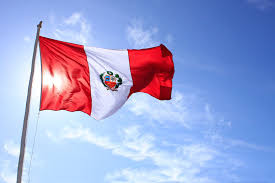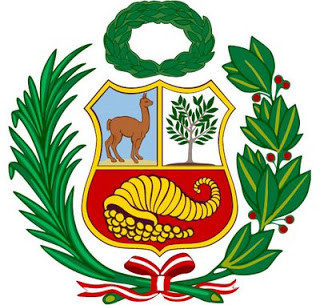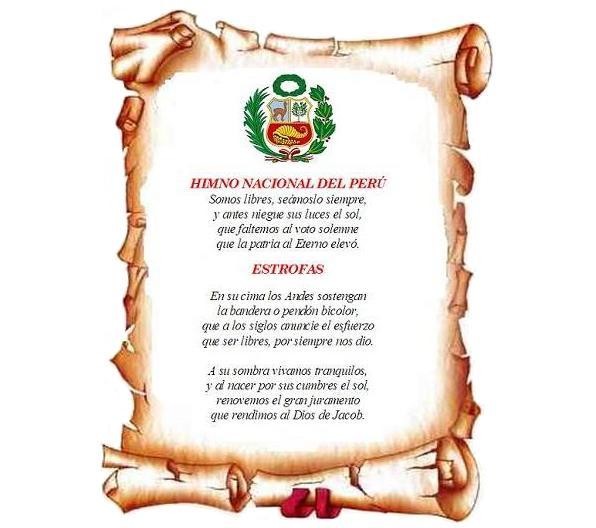Get to know the National Symbols of Peru during Peru Month!
Hello everyone!
I hope that you are all well.
For Peruvians, July is our national month of patriotism during which we sing our national anthem, fly our flags, and show off our national shield.
Peru has been a sovereign state since its independence from Imperial Spain in July 1821, and today I would like to share with you a few of our patriotic symbols and their relationship with specific places. For example, the port of Pisco where, according to tradition, Don José San Martín had a dream that inspired him to create the colours of the flag of Peru: red and white.
When thinking of an institution, an entity or a country, we immediately think about the things that, whether officially or informally, are related to it. For example, if we are talking about Argentina, we think about the colours light-blue and white, their Argentinian grill and the tango. If we think about Peru, we think about the food, red and white, and the national anthem.
At the time when the Republic was established, the defining symbols of Peru occupied a position of great importance as they give the people a strong sense of identity. Therefore, through these symbols, Peru found a way to rid itself of its colonial past and fashion an entirely new identity for itself.
The symbols were created during first few years of independence, when Peru was fighting to be free from South America. Peru's representation to its people was vital for what it wanted to construct in the future, and it was in these circumstances that the national symbols were created, even before the nation was created in itself.
One of the first symbols of Peruvian identity was undoubtedly the national anthem and the national flag, our beloved red and white.
The Peruvian Flag

In this context, Don José de San Martín took on a protagonist role and it was him that established the first flag of Peru and national anthem. The Peruvian troops needed a flag that distinguished them from the Argentinian and Chilean armies, however it is not known for certain as to why the red and white colours remained.
Don José de San Martín disembarked in Paracas and the legend tells us that he fell asleep under a palm tree and when he woke up he saw a flock of pariwanas flying with the colours red and white, therefore acting as the inspiration for him to create, or decide to have the colours red and white in the flag of Peru.
This dream was announced by Abraham Valdelomar and was published on the 100 year anniversary of Peruvian emancipation. Maybe we will never know what truly happened that prompted the creation of the flag with those specific colours, but for now this legend is inextricably tied to the nation of Peru.
Everything has to change at some point, and so did the flag of Peru. The one created by Don José de San Martín was replaced, but the colours of red and white have remained forever.
The original design was changed and this was the one used by the Patriot army when they advanced against the Royalist forces, and so in 1821, the declaration of Peruvian independence was announced in the city of Lima holding the new flag high.
After this, it was decided to make changes to the flag once more, creating a second flag in 1822 which lasted less than 2 months. Easily confused with the Spanish flag of the time; their flag had yellow in the middle, this one had white.
The horizontal stripes were then changed back to vertical in the same year of 1822 with a sun embellished in the middle of the white stripe. Then, during 1825, Congress ratified the flag again, but this time without the sun in the middle.
The flag was present over the battles of Junin and Ayacucho, during which Peru finally sealed its independence.
The National Shield of Peru

The shield was also established by Don Jose de San Martín: inside it had a sun that rises with a calm sea. However, Don José de San Martín himself had decided that it should be used by the patriots and later be changed by the Peruvians themselves when the end of Peru's long-awaited independence finally developed.
The shield went through a more complicated process than the flag did, suffering various changes since nowadays it does not look anything like it did then.
One thing that was included in the first shield for example was the sun behind the mountains, a homage to the Inca culture. This shield lasted only five years and after this they proposed a new style: what they wanted Peru to look like from the outside had to be reflected in the shield of the young nation.
It was decided to add in floral elements into the shield, thanks to the influence from the French arriving from Europe. Here we have clear influences from Hipolito Unanue, giving an element to the llama, the cornucopia and the cinchona tree, making sure to tell the rest of the world how varied and rich life is in Peru.
This illustrated and republican coat of arms, which has been conserved until today, was created in the year of 1835, was proposed by the liberator who would later arrive in Peru: Don Símon Bolivar. .
The shield was created by a man from the Universidad Mayor de San Marcos (my university! ) and it was later modified and turned into stamps for the new coins of my beloved nation.
An important element of the shield is undoubtedly the llama, which represents finesse, independence and the Andean world, of which Peru is a part of, in addition to being considered as being one of the richest and finest places in the world.
The other well-known and fundamental element of the shield is the quina tree. There are many species of this tree throughout the world, but in Peru there are three natural variants of this miraculous tree due to quinine helping Europe and tropical countries to counteract the development of malaria.
During the Second World War, Peruvian quinine was used carelessly and almost disappeared from the face of the earth, but fortunately this delicate situation began to improve little by little.
The third element of the shield is our cornucopia, since it is a symbol of all the wealth of coins, indicating that we are a country with a lot of wealth and that we are full of treasures and one of the most prosperous nations.
The National Anthem

Our patriotic National Anthem unites every Peruvian and it was one of the first symbols with which Peruvian tradition started to take shape.
Such a multi-cultural country like Peru can not be summarised in total just by the letters in a hymn, but what it can do is to make us realise that we are a diverse country that holds out personalities within it, our wealth, and above all, it makes us special for the whole world.
The National Anthem of Peru has a stanza that created controversy, it said: "For a long time the Peruvian, oppressed, Dragged the ominous chain" (translation source). As we will see later on, this stanza that was used before the current one, still exists in Peru.
Also, the famous "chicha", another type of music, became popular too as it was created by the same pair that composed the National Anthem, some time afterwards. It has a rhyme that I love and it has a 100% Peruvian taste that is like harmony and happiness combined, with a touch of hope.
They organised a competition to create the National Anthem, and it is this that I remember from when I was a child, as during my school years we used to sing it at every Monday at assembly. When I was a girl and a teenager, we had our hymn created by two patriotic Peruvians and they had the most beautiful harmony in the entirety of Peru.
In Don José de San Martín's times, there were different patriotic songs and on the creation of the competition, the hymn that won was written by José de la Torre Ugarte and Bernardo Alcedo, and those are the words that we know today.
The original piano score of the National Anthem is a mystery and it has suffered many modifications through time, obviously this worries the executives of the country who want to maintain a standard, or a harmony within the National Anthem.
Despite the fact that the phrase "For a long time the Peruvian, oppressed, Dragged the ominous chain" was not created by the pair that one the anthem competition, this phrase was maintained with force due to Peruvian popularity, and ti was even a line that I sung when I was a girl!
Continuing on with this topic, and the controversial line: "For a long time the Peruvian, oppressed, Dragged the ominous chain". Bernardo Alcedo with Rebagliatti adapted a new National Anthem which has been lost until these last years. But that is not the end of the story, no! There is more, because in recent years, some stanzas have been changed by the government of ex-president Alan García.
Another thing that happened in the history of Peru, is that even later, they wanted to modify it more but the National Anthem was already so ingrained in the people and society that it was impossible to be able to make more changes.
The National Anthem of Peru is one of the most complicated, as musicians will tell you, it has an extremely special and angelic harmonic sequence.
Bernardo Alcedo lead the National Anthem and was an interpreter for an actress who was very famous in her time, called Rosa Merino, one of the people who they always used to teach us about in school about her debut. At least I can say that the first time National Anthem that I remember from my school days was sung in the theatre by Rosa Merino.
It is said that the National Anthem of Peru is one of the most beautiful National Anthems in the world.
What do you think?
One other thing I would like to share with you is that congress finally rejected Bernardo Alcedo's request to create a music school in Peru. It would seem like it would clash with the culture of Peru seeing as we think of ourselves more like "otorongos" - jaguars.
The Rosette

Well, the rosette isn't actually an official symbol of Peru, but it is an element that is always shown during the month of July in schools and also by Peruvians going to work or doing their daily activities. The rosette has the colours red and white inside of it, it acts as something that distinguishes Peruvians during the dates of patriotic parties in our beloved month of July!
Nowadays, the rosette is used by children, teens and adults.
As we have been able to realise, these symols have been present during many different historical events in Peru: the Peruvian flag for example, is a testament to those who sacrificed their lives during the times of war so that they could safeguard the independence of this great Inca nation.
These symbols are like our identity tickets that make us feel nostalgic when we are far away from home, like me, and they make us look back on everything that happened in Peru with love.
Thank you for reading this homage during Peru Month! Even though I am far away from my country, I am still celebrating as if I were there in the beautiful nation.
See you next time,
Until then, Long live Perú!
Photo gallery
Content available in other languages
Want to have your own Erasmus blog?
If you are experiencing living abroad, you're an avid traveller or want to promote the city where you live... create your own blog and share your adventures!
I want to create my Erasmus blog! →



















Comments (0 comments)